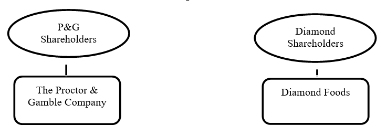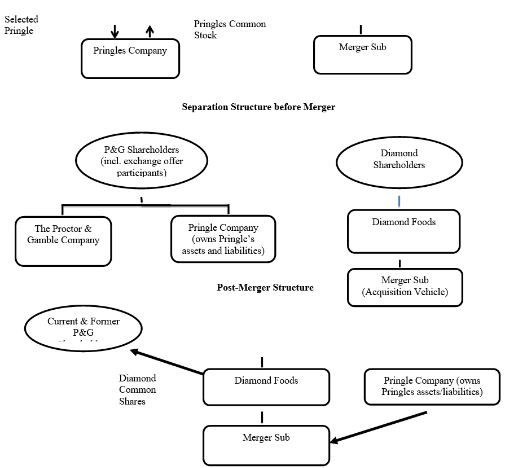The Anatomy of a Reverse Morris Trust Transaction:
The Pringles Potato Chip Saga
Greater shareholder value may be created by exiting rather than operating a business.
Deal structures can impose significant limitations on a firm’s future strategies and tactics.
_____________________________________________________________________________________________
Following a rigorous portfolio review and an informal expression of interest in the Pringles brand by Diamond Foods (Diamond) in late 2009, Proctor & Gamble (P&G), the world’s leading manufacturer of household products, believed that Pringles could be worth more to its shareholders if divested than if retained. Pringles is the iconic potato chip brand, with sales in 140 countries and operations in the United States, Europe, and Asia.
Diamond’s executive management had long viewed the Pringles’ brand as an attractive fit for their strategy of building, acquiring, and energizing brands. The acquisition of Pringles would triple the size of the firm’s snack business and provide greater merchandising influence in the way in which its products are distributed. The merger would also give Diamond a substantial presence in Asia, Latin America, and Central Europe. The increased geographic diversity means the firm would derive almost one-half of its revenue from international sales.
After extended negotiations, Diamond and P&G announced on April 15, 2011, their intent to merge P&G’s Pringles subsidiary into Diamond in a transaction valued at $2.35 billion. The purchase price consisted of $1.5 billion in Diamond common stock, valued at $51.47 per share, and Diamond’s assumption of $850 million in Pringles outstanding debt. The way in which the deal was structured enabled P&G shareholders to defer any gains they realize from the transaction and resulted in a one-time after-tax earnings increase for P&G of $1.5 billion due to the firm’s low tax basis in Pringles.
The offer to exchange Pringle shares for P&G shares reduced the number of outstanding P&G common shares, partially offsetting the impact on P&G’s earnings per share of the loss of Pringles earnings. Diamond agreed to issue one share of its common stock for each Pringles common share. The 29.1 million common shares issued by Diamond resulted in P&G shareholders’ participating in the exchange offer, owning a 57% stake in the combined firms, with Diamond’s shareholders owning the remainder.
The deal was structured as a reverse Morris Trust acquisition, which combines a divisive reorganization (e.g., a spin-off or a split-off) with an acquisitive reorganization (e.g., a statutory merger) to allow a tax-free transfer of a subsidiary under U.S. law. The use of a divisive reorganization results in the creation of a public company that is subsequently merged into a shell subsidiary (i.e., a privately owned company) of another firm, with the shell surviving.
The structure of the deal involved four discrete steps, outlined in separation and transaction agreements signed by P&G and Diamond. These steps included the following: (1) the creation by P&G of a wholly owned subsidiary containing Pringles’ assets and liabilities; (2) the recapitalization of the wholly owned Pringles subsidiary; (3) the separation of the wholly owned subsidiary through a split-off exchange offer; and (4) a merger with a wholly owned subsidiary of Diamond Foods. The separation agreement covered the first three steps, with the final step detailed in the transaction agreement.
Under the separation agreement, P&G contributed certain Pringles assets and liabilities to the Pringles Company, a newly formed wholly owned subsidiary of P&G. After P&G and Diamond reached a negotiated value for the Pringles Company equity of $1.5 billion, or $51.47 per share, the Pringles Company was subsequently recapitalized by issuing to P&G 29.1 million shares of Pringles Company stock. To complete the separation of Pringles from the parent firm, P&G distributed on the closing date Pringles shares to P&G shareholders participating in a share-exchange offer in which they agreed to exchange their P&G shares for Pringles shares.
In addition, the Pringles Company borrowed $850 million and used the proceeds to pay P&G a cash dividend and to acquire certain Pringles business assets held by P&G affiliates. Since P&G is the sole owner of the Pringles Company, the dividend is tax free to P&G because it is an intracompany transfer. If the exchange offer had not been fully subscribed, P&G would have distributed through a tax-free spin-off the remaining shares as a dividend to P&G shareholders.
The transaction agreement outlined the terms and conditions pertinent to completion of the merger with Diamond Foods. Immediately after the completion of the distribution, the Pringles Company merged with Merger Sub, a wholly owned shell subsidiary of Diamond, with Merger Sub’s continuing as the surviving company. The shares of Pringles Company common stock distributed in connection with the split-off exchange offer automatically converted into the right to receive shares of Diamond common stock on a one-for-one basis. After the merger, Diamond, through Merger Sub, owned and operated Pringles 

Prior to the merger, Diamond already had formidable antitakeover defenses in place as part of its charter documents, including a classified board of directors, a prohibition against stockholders’ taking action by written consent (i.e., consent solicitation), and a requirement that stockholders give advance notice before raising matters at a stockholders’ meeting. Following the merger, Diamond adopted a shareholder-rights plan. The plan entitled the holder of such rights to purchase 1/100 of a share of Diamond’s Series A Junior Participating Preferred Stock if a person or group acquires 15% or more of Diamond’s outstanding common stock. Holders of this preferred stock (other than the person or group triggering their exercise) would be able to purchase Diamond common shares (flip-in poison pill) or those of any company into which Diamond is merged (flip-over poison pill) at a price of $60 per share. Such rights would expire in March 2015 unless extended by Diamond’s board of directors.
-How is value created for the P&G and Diamond shareholders in this type of transaction?
Definitions:
Willing to Pay
The maximum amount an individual is prepared to spend to acquire a good or service.
Utility Function
A mathematical representation in economics that describes how consumers allocate their income across different goods and services to maximize their utility or satisfaction.
Bureau of Fisheries
A government agency or department that manages and regulates fisheries, fish habitats, and sometimes aquatic environments to ensure sustainable use and conservation.
Fishing License
A legal authorization or permit required to engage in fishing within certain jurisdictions, usually to regulate fishing activities and conserve aquatic resources.
Q5: Both a divestiture and a spin-off generally
Q14: How could Verizon Communications have protected itself
Q23: JV and alliance agreements often limit how
Q64: Whenever the target firm's projected cash flows
Q68: LBOs can be of an entire company
Q74: If the acquisition of the target is
Q77: Which of the following is not true
Q89: Which of the following is not true
Q114: Speculate as to why P&G chose to
Q136: Why would the U.S. Internal Revenue Service